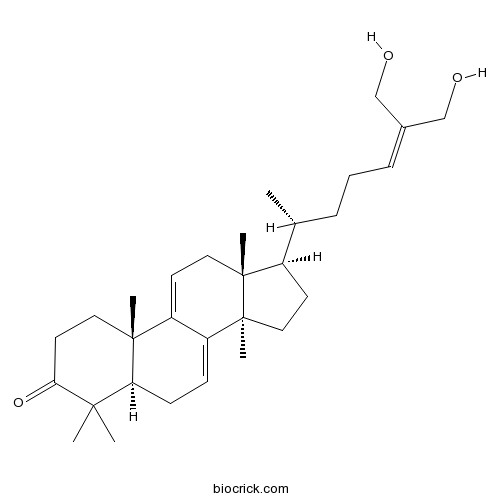InChI=1S/C30H46O3/c1-20(8-7-9-21(18-31)19-32)22-12-16-30(6)24-10-11-25-27(2,3)26(33)14-15-28(25,4)23(24)13-17-29(22,30)5/h9-10,13,20,22,25,31-32H,7-8,11-12,14-19H2,1-6H3/t20-,22-,25+,28-,29-,30+/m1/s1
Ganoderiol F( GolF) , a tetracyclic triterpene, was isolated from Ganoderma amboinense and found to induce senescence of cancer cell lines, it induces growth arrest of cancer cell lines HepG2, Huh7 and K562; activation of the mitogen-activated protein kinase EKR and up-regulation of cyclin-dependent kinase inhibitor p16 were found in early stages of GolF treatment and were presumed to cause cell-cycle arrest and trigger premature senescence of HepG2 cells; suggests that the growth-arrest and senescence induction capability on cancer cells suggest anticancer potential of GolF.[1]
Ganoderiol-F could be developed further as both anti-HIV and antimalaria, the affinity of ganoderiol-F is higher towards HIV-1 protease (binding energy= -11.40kcal/mol and Ki= 4.68nM) than to plasmepsin I (binding energy= -9.96 kcal/mol and Ki= 50.94 nM), meanwhile pepstatin-A has better affinity towards HIV-1 protease (binding energy= -4.52 kcal/mol and Ki= 496.13 uM) than to plasmepsin I (binding energy= -3.07 kcal/mol and Ki= 5.98 mM).[2]
Ganoderiol F shows binding activity to androgen receptor and inhibits LNCaP cell proliferation.[3]
English website: Ganoderiol F
Japanese website: Ganoderiol F
Chinese website: Ganoderiol F
[1] Chang U M, Li C H, Lin L I, et al. Life Sci, 2006, 79(12):1129-39.
[2] Levita J, Chao K H, Mutakin. Int J Pharm Pharmaceut Sci, 2014, 6( 5):561-6.
[3] Jie L, Tamura S, Kurashiki K, et al. Chem Biodivers, 2009, 6(2):231-43.
[4] Zhao J, Zhang X, Li S, et al. J Sep Sci, 2006, 29(17):2609-15.



